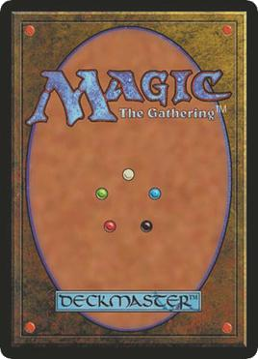 Art by Eric Fortune
Art by Eric FortuneHere it is; my discerningly curated Pauper Cube. There are many different pauper cubes, but this is mine. Is it better than other Pauper cubes? I really can’t say. But I think it’s very fun. I’ve put a lot of work into fleshing out the archetypes over time and ensuring that there is proper synergy between the cards. Some Pauper cubes go for raw power and just include cards that are strictly better than everything else. I’ve eschewed that philosophy and have opted to include cards that have good overlap in abilities, leading to cohesive decks that have specific aims.
It’s a 450 card cube. It used to be 420 cards, because the Community Pauper Cube (a cube maintained by a whole community, with cards being added via a voting process) is 419 cards. This is an arbitrary number created by the originator of the Community Cube. Mines used to be the Community Cube. I added one extra card to make it a nice round number, and because 420 has special, “mystical” connotations. I have since expanded it to 450 to make it a “proper” cube number. In my experience, Pauper cubes work best when they’re smaller. There is a huge pauper pool, but when you expand to 540 there is almost too much redundancy and cards stop having their own special meanings; they just become more copies of the same thing. 450 feels like a sweet spot for ensuring variance, while still allowing each card to shine as doing something unique.
Unlike my retro-frame cube - the Ye Old Vintage Cube - every color pair in this cube is intended to function in a specific way, with some convenient overlap for splashes. Gold cards work as signposts to indicate what a color pair should be aiming to do. The archetypes by color pair are as follows:
Blue and Red are always the colors that love slinging spells at instant speed and getting benefits for doing so. Within this archetype, you do have some options for how the deck can play. The obvious way is by building a deck around prowess creatures like Monastery Swiftspear. We also have “spellslinging matters” creatures like Thermo-Alchemist and Firebrand Archer, so your spells can be pinging away while also pumping your prowess critters. The second, more control-oriented build looks to use burn spells and bounce spells to keep the board clear early on, then cast Tolarian Terror or a massive Serpentine Curve in the late game to close the game.
Blue and Black is a nebulous pairing that can serve both control and tempo. The tempo deck, however, is very specific - it’s Ninjas. This deck wants you to be juggling creatures, so you can cast controlling creatures like Chittering Rats or Liliana’s Specter and then ninjitsu them back to your hand for replay value with cards like Moon-Circuit Hacker. The other option in Dimir is straight control, which gains incremental advantage by being able to utilize the graveyard far more efficiently than your opponent. Cards like Dihada’s Ploy and Notion Rain help you sift through your deck for removal and counterspells, while filling your grave with cards like Advanced Stitchwing and First-Sphere Gargantua that can come back later in the game. There is some obvious overlap here with cards like Tolarian Terror and Serpentine Curve.
It’s the classic Blue/Green Miracle-Grow deck, but in pauper, I guess. Drop a turn 1 Cloudfin Raptor or Experiment One and continue to follow it up with bigger creatures to see that baby blossom into a serious threat. This archetype wants you to be ramping so you can keep casting bigger creatures to trigger evolve. I think there’s currently some tension between this pairing and Green-Red, both of which do similar things, and might be competing for some of the same creatures.
A very popular archetype, since Pauper is so value oriented. There are so many things you can be doing here to recur value. Archaeomancer loops are a serious thing, as is getting endless value off of Custodi Squire and/or Mulldrifter. It’s really a deck that wins simply by out-valuing your opponent and overwhelming them with midrange creatures.
Green and White wants to go wide and create a lethal board by buffing weenies through counters or anthem effects. There’s not much to say here. That’s just what the archetype does, and it’s very straightforward. There are lots of creatures like Jungleborn Pioneer and Attended Knight that give you extra bodies when cast. You also have cards like Cloakwood Swarmkeeper that get buffed when tokens come into play. Make good use of those +1/+1 counters by adding creatures like Gnarlid Colony and Ainok Bond-Kin to add abilities to your augmented army.
So there’s really a Jeskai Prowess deck hidden in this cube. You have cards like Tenth District Legionnaire and Seeker of the Way that serve an aggro plan, but also want you to be slinging spells. Legionnaire is unique because it needs to be targeted. That’s where cards like Faerie Guidemother and Rimrock Knight come in, allowing you to buff creatures, while also getting bodies out of them a turn later. There’s also the Impact Tremors deck in which you’re using token generator like Hordeling Outburst and Mogg War Marshal to ping your opponent, building up an army you can pump with an anthem effect like Marshalling Cry.
Black and White is another incremental control deck, and it can play out as an Orzhov life-drain deck, or an Aristocrats deck. It has a lot of overlap with Rakdos (Black & Red), but Rakdos is the more aggro build of aristocrats, while Black & White is the slower build. This deck wants you to be finding sacrifice engines like Carrion feeder, Cartel Aristocrat (The archetype’s namesake) and Lampad of Death’s Vigil to feed creatures to. This allows you to use cards like Falkenrath Noble to slowly drain your opponent. You can also benefit from creatures entering with some lifegain cards, and you have Celestial Unicorn that benefit from gaining life.
I’m calling the gravechurning deck Tortex due to it’s Pauper constructed namesake - Tortured Existence - but the deck doesn’t need Tortex to succeed in what it does. You’re just looking to fill the grave with creatures that can constantly be recurred, either by dredging them back, escaping them, or by some other means like Pulse of Murasa. Some creatures can serve as fodder for Bloodthrone Vampire or Phyrexian Ghoul, or you can just try to get you grave filled to cast a monster like Writhing Necromass.
As stated above, this is similar to the Black & White aristocrats build (some overlap) but tends to be much more aggressive. This deck wants you to use cards like Krenko’s Command and Putrid Goblin to feed creatures that can benefit aggressively from the sacrificial offerings, such as Phyrexian Ghoul and Fireblade Artist. Scorched Rusalka is another card that can make quick use of tokens. Or you can just turn all your creatures sideways and overwhelm the opponent through combat.
This archetype just wants to ramp very quickly to start dropping fat threats. You have a plethora of mana dorks that can be cast on turn 1 to curve into turn 3 plays like Jewel Thief and Migratory Greathorn, which in turn just help you ramp harder so you can start casting huge beasts like Annoyed Altisaur and Ironhoof Boar. There’s a bit of a 4-power matters theme, found in cards like Kronch Wrangler and drowsing tyrannodon, and it should be easy to start turning this on early since we’ve even got creatures like Circle of the Moon Druid that can come down turn 3 with 4 power.

